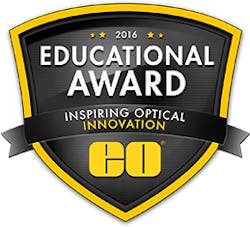
Optical components maker Edmund Optics (EO; Barrington, NJ) has named the 2016 Educational Award recipients—an award given in recognition of outstanding undergraduate and graduate optics programs in science, technology, engineering, and mathematics at non-profit colleges and universities worldwide.
The EO Educational Award Team evaluated over 600 applications to select 30 global finalists, with applications including a vision system that tracks the rotation of a log as it travels down a sawmill production line; an ultrafast volumetric imager of neurovascular dynamics in the neocortex of awake mice; and the development of a new optical coherence tomography (OCT)-based elasticity imaging system to quantify changes in tissue mechanical properties caused by disease, and to provide a way for earlier diagnosis and better treatment.
$45,000 in the company's products will be awarded to the Gold, Silver, and Bronze winners in the Americas and Europe, in support of their research. The remaining finalists will all receive a $500 product matching grant to assist with their research. Also, the Norman Edmund Inspiration Award, which is an additional $5000 in products, will be given to one of the global finalists on November 9, 2016.
In the Americas, the Gold Award ($10,000 in products) was awarded to the University of Wisonsin-Madison (Madison, WI), and was submitted by Edgar Spalding for research on the genetic control of plant growth and development with high-throughput, high-resolution machine vision assays.
The Silver Award ($7500 in products) went to Cinvestav (Mexico City, Mexico), submitted by Jairo Salazar for the design and development of a low-cost hyperspectral image sensor (HIS) used to develop new applications for precision agriculture, recycling, remote sensing, manufacturing, and defense and health industries.
The Bronze Award ($5000 in products) went to the University of California, Davis (Davis, CA) and was submitted by Oybek Kholiqov for the development of interferometric near-infrared spectroscopy (iNIRS) for real-time quantitative monitoring of oxygen metabolism and cerebral blood flow.
In Europe, the Gold Award (€7,000 in products) went to Deutsches Zentrum für Neurogenerative Erkrankungen (DZNE; Bonn, Germany), which was submitted by Severin Filser for research into the development of a minimally invasive microendoscope to analyze corticostriatal network dysfunction in Parkinson's disease, combining two-photon polarization microscopy and gradient index optics.
The Silver Award (€5,000 in products) was presented to Imperial College London (England) and submitted by Mads Sylvest Bergholt for the development of a wide-field NIR Raman imaging probe for intraoperative margin assessment using novel optical design and engineering.
The Bronze Award (€3,000 in products) was awarded to The Institute of Photonic Sciences (ICFO; Barcelona, Spain), which was submitted by Bárbara Buades Sabater for research on ultrafast electron dynamics at a sub-femtosecond scale to understand how sensors and transistors work and how energy is stored.
To learn more about the Educational Award recipients and their applications, please visit www.edmundoptics.com/award.